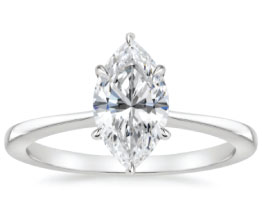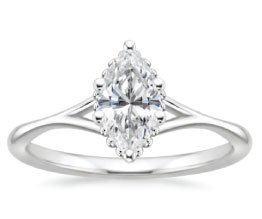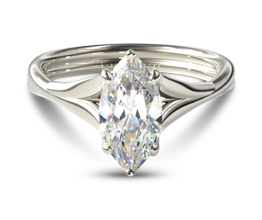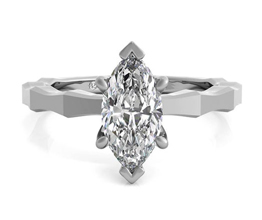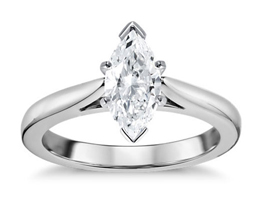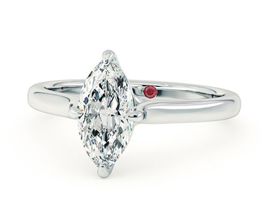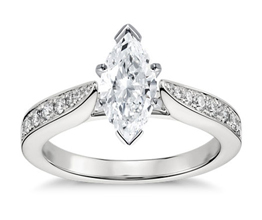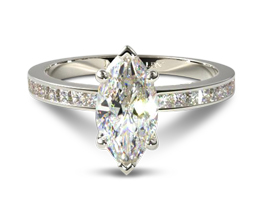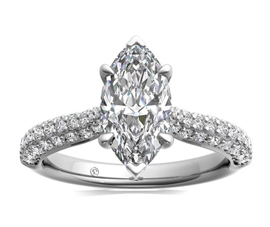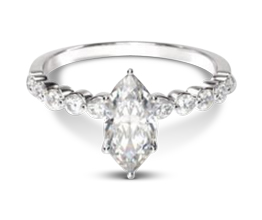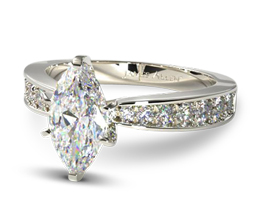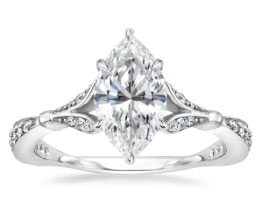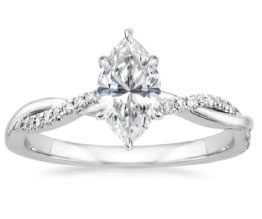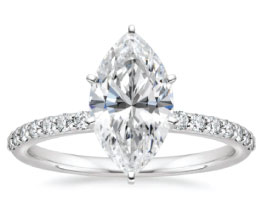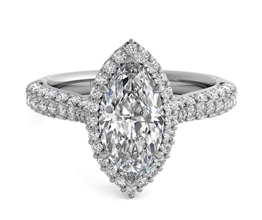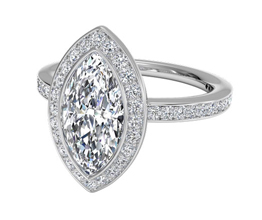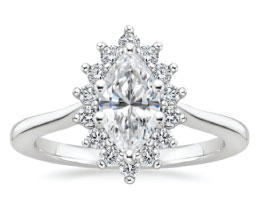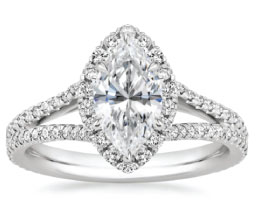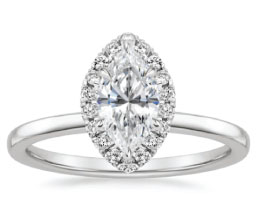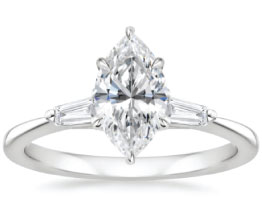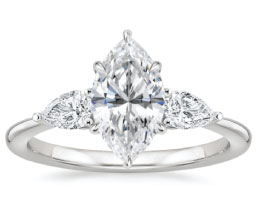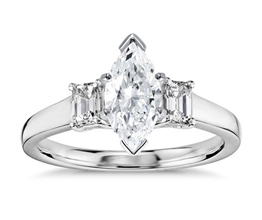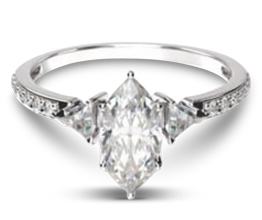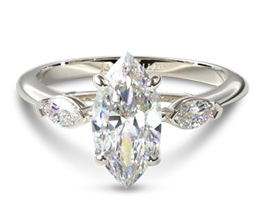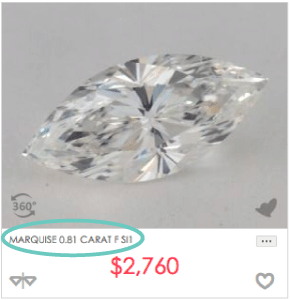Marquise engagement rings
How to get the best marquise diamond ring
Ringspo is reader supported
Ringspo is reader-supported, which means we may receive a commission if you click a link to a retailer & subsequently make a purchase.
We feature links to several retailers to help readers find the one that is the best fit for them. Find out more about how Ringspo works here.
Legend has it that the shape of Marquise engagement rings comes from the smile of the mistress of Louis XIV of France. He requested that the state jewelers cut a stone to be as brilliant as, and match the shape of, her smile.. Pretty brave to go for his girlfriend’s smile, rather than his wife’s!
The modern cut of the marquise is probably much different to the one that was originally created. Modern knowledge about how light travels through diamonds and is reflected off surfaces has been utilised to make the Marquise one of the ‘brilliant’ cuts, meaning that the angles between the surfaces of the stone have been optimised to reflect as much light as possible, making it sparkle brilliantly.
Despite this, it can be one of the most difficult shapes of diamond to buy due to the huge variation in the diamonds out there and the large number of poor quality stones.
We’re going to look at:
- What’s good about marquise diamond engagement rings
- What’s bad about marquise engagement rings?
- Marquise engagement ring setting styles
- A marquise engagement ring buying guide to tell you what you really need to know
- Recommended specs
Do you know the 4Cs?
Much of the information on this page will focus on diamonds, as getting that right is key to getting an awesome ring for a great price. If you’re not familiar with the 4Cs of diamonds then I’d recommend reading this page which gives an overview of what you really need to know.
Why Marquise Diamonds Are a Great Choice
Marquise diamonds are well-priced
Diamonds that aren’t the traditional round shape are known as ‘fancy’ shapes, and they are all considerably less expensive than a round brilliant stone.
The marquise is one of the fanciest shapes of all, with its brilliant facets an elegant shape, but it’s also one of the most competitively priced diamond shapes.
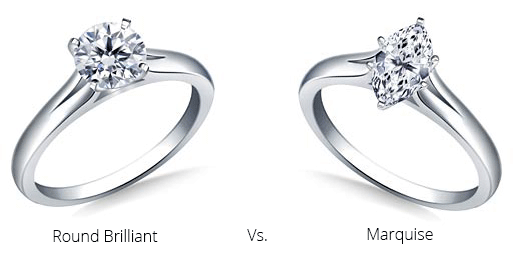
The table below shows the price difference on of our recommended retailers between a round brilliant diamond and a marquise cut diamond of the same size and quality:
- 1 carat
- Color F
- Clarity VS1
Here’s how they compare:
| SHAPE | PRICE (US$) | DIFFERENCE (US$) | DIFFERENCE (%) |
|---|---|---|---|
| Round Brilliant | 6,610 | ||
| Marquise | 3,973 | -2,637 | -39.9 |
That’s nearly a 40% saving, just for changing the shape of the stone, which is definitely not to be sniffed at. The exact proportion that you save will be dependant on the size and the quality of the stone that you’re looking at, but there will always be a considerable saving available.
Marquise diamonds look very large for their carat weight
The ideal proportions for a marquise diamond is shallow and wide. Some diamond shapes need to be cut much deeper to bounce the light off the internal surfaces in the correct way, which means that a lot of the weight of the stone is in the bottom half, where it can’t be seen once it’s in a ring setting.
But because the marquise is shallow, it has a larger surface area, so actually looks considerably bigger than most other shapes. The picture below is a to-scale diagram of a 1 carat round brilliant diamond and a 1 carat marquise – you can see that the marquise looks much bigger, even though it weights the same.
The exact dimensions of a marquise will change depending on each individual stone. If you check out a gallery of marquise diamonds and compare a few stones, you’ll quickly see that there is considerable variation in their size.
Marquise diamonds are flattering
Another advantage of the marquise shapes is that is gives a flattering elongation effect for shorter fingers. Marquise diamond engagement rings always have the stone mounted along the finger, which will make the finger look longer and more slender than it really is.
Marquise diamonds are forgiving
Lastly, as one of the sparkly ‘brilliant’ cuts, the marquise can be a little more forgiving of lower clarity grades than other, less sparkly shapes. The fire (coloured light) and brilliance can help to hide minor imperfections and a lower color grade.
Things to be careful of with marquise diamonds
Marquise diamonds often exhibit the ‘bow tie effect’
The biggest negative of the marquise shape for diamonds is the same one that affects all of the other elongated shapes of diamond too – the ‘bow tie effect’.
The bow tie effect is a dark shadow that can appear in the middle of the stone when viewed from certain angles. It appears because light is reflected off the bottom of the stone and out of the sides, rather than back through the top of the diamond to the viewer’s eye.
How visible the bow tie effect is depends on how well each individual stone has been cut, but an excellent cut diamond will dramatically reduce its visibility.
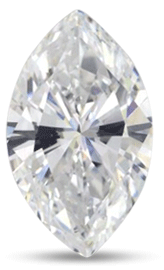
The best way to judge a marquise’s bow tie effect is to just look at it – if you check out a gallery of marquise diamonds, you’ll see that some suffer badly, while in others it’s hardly visible at all.
Marquise diamonds can be delicate
The other thing to be careful about with marquise engagement rings is that the sharp points at either end, and the narrow ‘girdle’ (the edge that runs around the stone) are relatively delicate, which make it vulnerable to potentially being chipped if it is hit on a hard surface.
Although diamonds are the hardest naturally occurring material out there, care does still need to be taken of them, so if the person who is going to be wearing the ring has a reputation as a bit of a klutz, another elongated style without the exposed points may be a better option for them e.g. the oval.
Marquise engagement ring settings
Marquise diamonds lend themselves extremely well to a range of settings, and the elegant shape of the stone can elevate even a simple setting into something really special.
This settings below are by no means a definitive collection, but is a selection to show the variety available within each setting style. If you see a setting style that you like, click through to find out more about it.
Marquise solitaire diamond engagement rings
The solitaire setting will allow your marquise diamond to sparkle as brilliantly as it possibly can because it allows the most light to enter the stone.
While solitaire settings for most other shapes of diamond only have 4 prongs, the Marquise has two extra V-shaped prongs at either end of the stone to hold the points firmly in place and give them a measure of protection as they are the most fragile parts of the diamond.
Scroll across to check out a selection of marquise cut solitaire engagement ring options, and click through to find out more about each one.
Pavé marquise diamond engagement rings
Adding ‘micropavé’ to the band (a large quantity of small, supporting diamonds) settings like this can up the bling factor of any ring, as the smaller stones catch the light at different times, giving the ring band a shimmering effect.
Marquise diamond halo engagement rings
Halo setting are always a great way to further increase the wow-factor of a ring, and can mean that a smaller center stone appears larger than it really is. The halo adds a considerable amount of bling without the considerable expense that a large upgrade to the size of the center stone would involve.
Marquise diamond three stone engagement rings
Three stone rings are another good way to add support to the center stone increase the impressiveness of a marquise ring. As the marquise shape is so long and slim, the added width of the three stone setting can balance out the shape of the ring, without overwhelming the center stone.Previous
Marquise diamond buying guide
Despite being an excellent choice for style and sparkle, marquise diamond engagement rings are still something of an alternative choice. The low demand means that most bricks and mortar stores will have an extremely limited choice of rings to pick from, if they have any at all. However, online retailers will have a much larger selection and allow you to dial in the specifications to exactly what you want.
In this section we’ll look at each of the 4Cs of diamonds for marquise, with recommendations on how to get the most beautiful stone and the most value.
Marquise diamond cut quality
Unlike the round brilliant cut, most laboratories don’t grade marquise diamonds with an overall ‘cut grade’, which definitely makes it a bit more difficult to ensure that you’re getting a quality stone. So, in this section we’ll take a look at what you should look at to ensure that you get the most brilliant stone possible while reducing the bow tie effect.
Marquise diamonds Length / width ratio
The length to width ratio is, unsurprisingly, the ratio between the length of the stone and the width. This is important for a couple of reasons. The first is because it affects how the stone looks. A lower length / width ratio will result in a stone that looks shorter and wider, while a high ratio will result in a stone that is longer and skinnier.
Usually a ratio of 1.75:1 to 2:1 results in stones that look visually pleasing. To me, anyway! The exact ratio that you go for is down to personal preference- whichever one you like the look of.
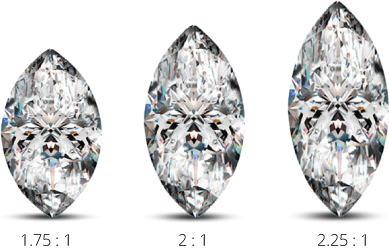
Another reason that the L / W ratio is important though is because it can affect the degree to which the bow tie effect that is visible: a stone with a ratio over 2.1 is more likely to have a significantly visible bow tie effect.
However, the only way to really judge how visible the bow tie will be is to examine the stone that you are considering buying. Brilliant Earth’s image show every stone from 360 degrees, which allows you to judge how much of a bow tie effect will be present.
Marquise Diamond Symmetry
Symmetry is important for marquise settings to ensure that the stone not only looks good, but also reflects light properly. The two ends should be inline with each other and the two sides should be mirror images of each other.
If possible, it’s best to be able to see the actual stone that you are looking to purchase. However, if there are no images available of the stone online then you can rely on the grading report, as long as it is from a reputable certifying agency – sticking to either GIA or AGS is my recommendation. You should be looking for an ‘excellent’, or ‘very good’ at a minimum, symmetry grading on the report.
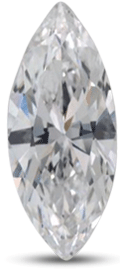
Poor symmetry – the top point is not aligned with the bottom point and the wings (sides of the stone) are not even.
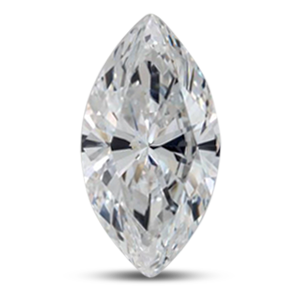
Excellent symmetry – the points are aligned and the wings are even and pleasingly curved.
Marquise Diamond Depth Percentage
Depth percentage is the ratio of the depth to the width of the stone:
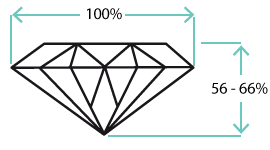
It has a less obvious effect on the overall appearance of an oval diamond compared to some other shapes, but does play a big part in how prominent the bow tie effect is. It can also affect how much light is reflected back to your eyes and therefore how much the diamond will sparkle.
Aim for a depth % within the ‘excellent’ range in the table below:
| Excellent | Very good | Good |
|---|---|---|
| 56% – 66% | 54% – 72% | 52% – 76% |
Marquise Diamond Table percentage
The ‘table’ of a diamond is the large, flat area on the top of the stone.
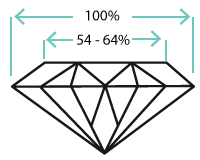
The size of the table in relation to the rest of the stone is important because the table is where the majority of light enters the stone. This needs to be carefully balanced with the other proportions to ensure that the correct amount of light enters the stone to allow for maximum sparkle. A larger table is not always better.
If you can, look for a marquise diamond with a table percentage within the excellent range below to ensure that you get the best sparkle. The ‘very good’ table range will also mean that your diamond will perform well.
| Excellent | Very good | Good |
|---|---|---|
| 54% – 64% | 52% – 66% | 50% – 68% |
The best way to use the above percentages is to enter them into the ‘advanced’ options on online jewelers search tools so that you only see stone that fit within the desirable specs. If you can, try and get ‘excellent’ for both depth percentage and table percentage to ensure that your stone sparkles as brilliantly as possible.
Marquise diamond color
Most brilliant cuts are quite forgiving of a lower color grade. The sparkle and brilliance that the brilliant cut generate can hide the true color of the stone, meaning that you can go slightly lower on the colour grading scale but it won’t be immediately noticeable.
But although it is a brilliant cut diamond, marquise stones are different. The points of the stones tend to concentrate the colour and make the stone appear darker, so any yellow tones will show up much more clearly.
The image on the below clearly shows that the middle of the diamond is quite colorless, but the points have a much warmer, almost yellow color.
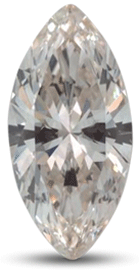
So, while with some shapes you can safely go to I on the colour scale without any danger of it appearing noticeably yellow, with marquise engagement rings I’d recommend going to G as a minimum if you want your stone to appear white.
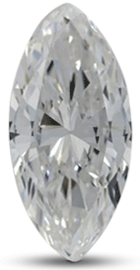
Color E – extremely white, but also more expensive as more rare
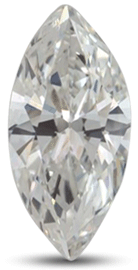
G color – a great mix of colorless and value
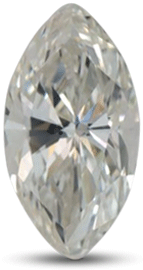
color – yellow ‘warmer’ tones much more obvious
If you go lower than G then your stone won’t necessarily immediately look yellow straight away, but will have warmer tones, rather than the ice white that many people are looking for with their diamonds.
Marquise diamond clarity
Again, the pointed ends of marquise diamonds means that you will have to go with a slightly higher clarity rating than with other brilliant cut stones to ensure that any inclusions aren’t visible.
Going with a VS2 grading or above will ensure that your stone is eye clean throughout. If you are considering either a Slightly Included stone (either SI1 or SI2), then ensure that you can get a high quality magnified image of the exact stone that you’re investigating, to make sure that no flaws are visible – Brilliant Earth and James Allen are the best for this.
Marquise diamond carat weight
Carat weight is something that people often get overly hung-up on. They want to choose a stone with a certain carat weight, even if it means that they end up making sacrifices on other, more important attributes of the ring.
The relationship between a diamond’s carat weight and its visible size isn’t always a direct one. When we judge a diamond’s size, we look at it from the top – known as the ‘face up’ position in the jewelry trade. However, much of the weight of a diamond is actually carried on the bottom half of the stone, where it can’t be seen.
The images below show the difference in size for marquise cut diamonds at a range of carat weights:
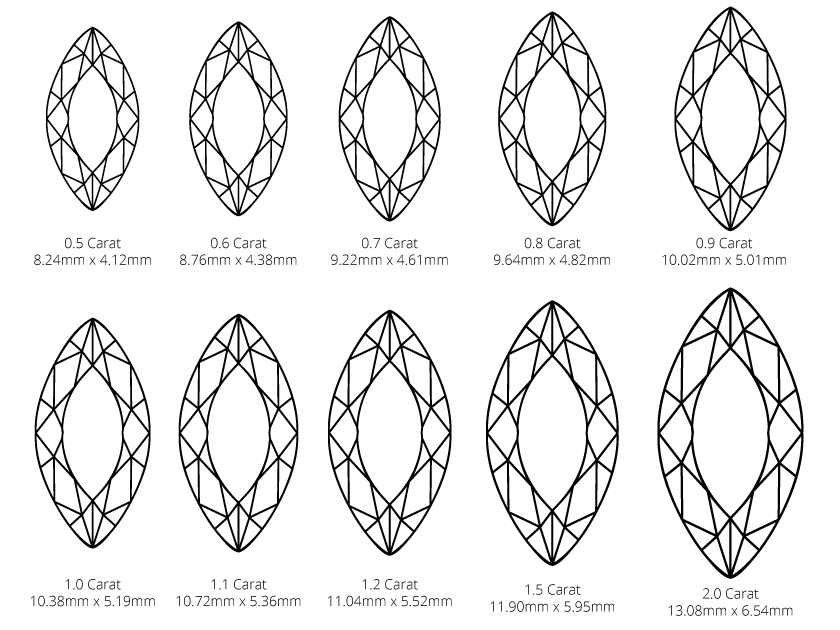
Hopefully you can see that increasing the carat weight doesn’t necessarily translate into a much visibly larger diamond. Changing the size from 0.8 carat to 1 carat is an increase in width of less than 0.4mm – less than 10%. However, the difference in price will be much more significant – over 75%:
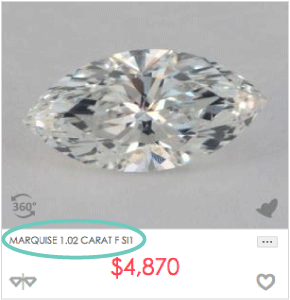
Compare to 1 carat diamond prices here
The priority that you place on diamond carat weight and how big you want to go is totally up to you. However, my recommendation is that you definitely don’t make it the most important attribute when choosing your engagement ring. Get the setting you love, find a diamond with a great cut that is going to sparkle brilliantly, make sure that it is eye-clean and has a good color and then see what carat weight you can fit into your budget.
A well-rounded diamond with excellent sparkle will much much more impressive than a big stone with obvious flaws.
Marquise diamond certification
The fifth C, and a very important one too. When looking at any diamond, you need to ensure that any diamond that you’re looking at is a ‘cert stone’, which means that it has been assessed, graded and coded with a laser by an independent lab.
Each certificate has a unique report number and detailed information about the stone, covering the four Cs, the height, depth and other info. As well as providing assurance that the stone that you’re buying is the quality that you are paying for, a certificate also proves what you’re buying is not a substitute.
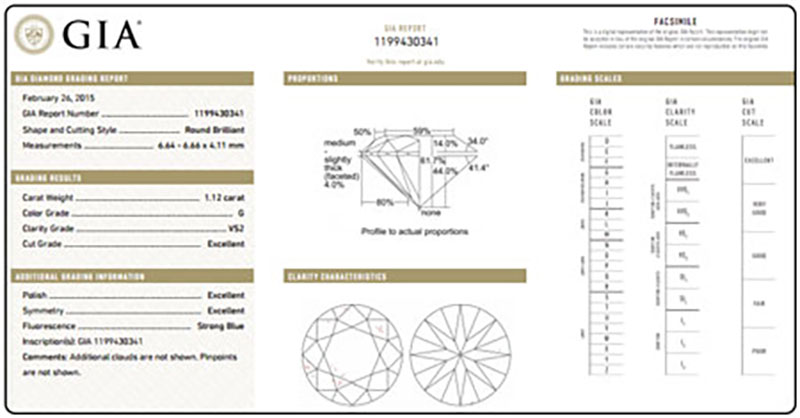
The lab to trust and to look for certification from is the non-profit Gemological Institute of America (GIA). It’s the most internationally recognised and generally seen as the most impartial of all of the gem labs.
The reason that the GIA is so well respected is because most others labs are part of trade bodies that contain jewelry retailers, or are ‘for profit’. While the GIA is very consistent with its gradings, the others have a reputation for being overly generous. What the GIA say is merely a diamond with a ‘good’ cut, maybe be graded ‘excellent’ by another lab, with an excellently large price to match.
Diamond certificates are what makes buying online safe and the best way to get a fantastic diamond at the lowest price. Knowing that each diamond you’re considering has been measured and graded by independent experts allows you to make an informed decision. You can take your time to consider the differences between diamonds and make sure you choose what experts have graded as the best stone, meaning that you get your perfect engagement ring at the best possible price.
Recommended specs
These specs are the minimum that we recommend to ensure that the diamond on your marquise diamond engagement ring looks fantastic.
You can of course go higher than these specs, if your budget allows, but for many of the characteristics you are paying for improvements that are very difficult, if not impossible, to see by the naked eye, especially when mounted in a ring setting.
| Clarity: | VS2 |
| Color: | G |
| Symmetry: | Very Good |
| L/W ratio Depth % Table %: | Very Good |

